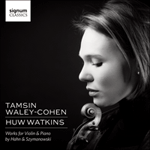The sound world of the C major Violin Sonata of 1926 assuredly visits the Fauré of fifty years earlier, the opening movement’s easy lyricism and textural transparency bearing a kinship with the elder French musician’s A major Sonata of 1877. Structurally set in a traditional sonata form, both of the themes of the opening movement (Sans lenteur, tendrement) are imbued with Gallic restraint and supple expressivity. The second movement, Véloce (in ternary form with a harp-like central portion), skits across its scherzo terrain with lucidity and no little verve, and an unusual concluding Modéré movement (marked très à l’aise, au gré de l’interprète) is for the most part gentle, melancholic and nostalgic. Such sorrowfulness is broken only by the urgency of a central (interrupted) climax and then (following a wonderfully hypnotic moment of harmonic ‘questioning’) by a foreshortened reprise of the sonata’s opening as the dark clouds of nostalgic longing are dispersed.
from notes by Jeremy Filsell © 2004
L’univers sonore de la Sonate pour violon en ut majeur de 1926 rend sûrement visite au Fauré de cinquante ans auparavant. Le lyrisme aisé et la transparence de texture du premier mouvement ressemble à la Sonate en la majeur de 1877 de ce musicien compatriote. Du point de vue de la structure, elle suit une coupe sonate traditionnelle où les deux premiers thèmes du premier mouvement (Sans lenteur, tendrement) sont imprégnés d’une retenue française et d’une expressivité souple. Véloce (de forme ternaire avec une section centrale aux allures de harpe) s’aventure sur le terrain du scherzo avec lucidité et une verve à ne pas négliger. La sonate se conclut par un mouvement inhabituel, Modéré (portant l’indication très à l’aise, au gré de l’interprète), qui est d’une manière générale doux, mélancolique et nostalgique. Un tel désespoir ne s’interrompt que grâce à l’urgence de l’apogée central (qui s’interrompt) et (après un merveilleux moment hypnotique de «questionnement» harmonique) à la reprise écourtée du début de la sonate, alors que les nuages sombres de langueur nostalgique se dispersent.
extrait des notes rédigées par Jeremy Filsell © 2004
Français: Isabelle Battioni
Die Klangwelt der C-Dur Violinsonate von 1926 bezieht sich deutlich auf diejenige Faurés fünfzig Jahre zuvor: der fließende, lyrische und transparente erste Satz ist mit der A-Dur Sonate von 1877 des älteren französischen Musikers offensichtlich seelenverwandt. Der erste Satz steht in der traditionellen Sonatenhauptsatzform, wobei beide Themen (Sans lenteur, tendrement) von gallischer Zurückhaltung und geschmeidiger Expressivität erfüllt sind. Das Véloce (in dreiteiliger Form mit einem harfenähnlichen Mittelteil) kommt im Scherzo recht schwungvoll und nicht ohne Verve daher. Der ungewöhnliche Schlusssatz, Modéré (überschrieben mit très à l’aise, au gré de l’interprète), ist größtenteils melancholisch, zart und sehnsüchtig angelegt. Diese Traurigkeit wird lediglich von einem sehr dringlichen, zentralen (unterbrochenen) Höhepunkt durchbrochen und dann (nach einem herrlichen, geradezu hypnotisierenden Moment harmonischen „Fragens“) von einer verkürzt erscheinenden Reprise des Anfangs der Sonate, wenn die dunklen Wolken der nostalgischen Sehnsucht zerstreut sind.
aus dem Begleittext von Jeremy Filsell © 2004
Deutsch: Viola Scheffel


 Szymanowski & Hahn: Violin Sonatas
Szymanowski & Hahn: Violin Sonatas
